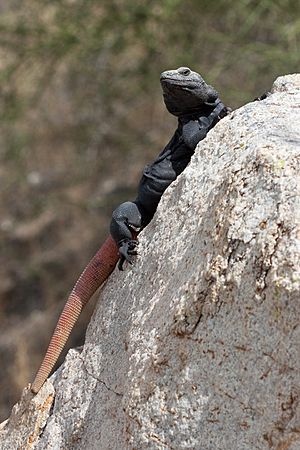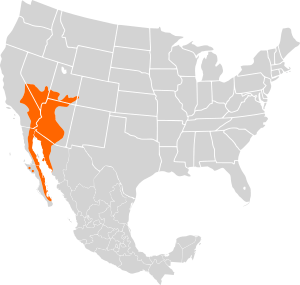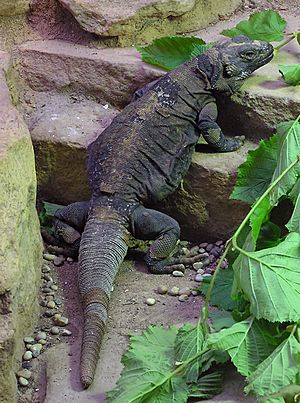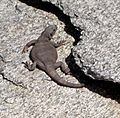Common chuckwalla facts for kids
Quick facts for kids Common chuckwalla |
|
|---|---|
 |
|
| Conservation status | |
| Scientific classification | |
| Genus: |
Sauromalus
|
| Species: |
ater
|
 |
|
| Approximate range of S. ater | |
| Synonyms | |
|
Sauromalus obesus (Baird, 1859) |
|
The common chuckwalla (scientific name: Sauromalus ater) is a type of lizard that belongs to the Iguanidae family. These cool lizards live in the hot Sonoran Desert and Mojave Desert areas. You can find them in the Southwestern United States, like eastern California, Utah, and Nevada. They also live south into northwestern Mexico, including Baja California and Sonora.
Contents
What is a Chuckwalla?
The Name "Chuckwalla"
The common name "chuckwalla" comes from a word used by Native American tribes. It comes from the Shoshone word tcaxxwal, or caxwal. This was the word used by the Cahuilla people who live in southeastern California.
Scientific Name Meaning
The scientific name Sauromalus ater also has a special meaning. The first part, Sauromalus, comes from two ancient Greek words. Sauros means "lizard" and omalus means "flat". The second part, ater, is Latin for "black" or "dark". So, its name describes it as a "flat, dark lizard".
How to Spot a Common Chuckwalla
Size and Shape
The common chuckwalla is a large, flat-bodied lizard. It has a big, rounded belly and a wide, blunt tail. These lizards can grow up to 20 inches (about 50 cm) long. They can weigh around 2 pounds (about 0.9 kg). Their bodies are covered in small scales, but they have larger scales around their ear openings.
Colors and Patterns
The color of chuckwallas changes depending on where they live. Their colors also differ between young lizards and adults. Males and females often look different too.
- Adult males usually have a black head, shoulders, and hips. Their middle body is a light tan color with brown speckles.
- Adult females are mostly brownish. They often have scattered dark red spots on their bodies.
- Young chuckwallas have four or five wide bands across their bodies. They also have three or four bands on their tails. Males lose these bands as they grow up, but females might keep some of them.
Chuckwalla Behavior and Habits
Staying Safe from Danger
Chuckwallas are harmless to humans. When they feel threatened, they quickly run into cracks between rocks. Once inside, they inflate their lungs with air. This makes their bodies swell up and wedges them tightly in place. This trick makes it very hard for predators to pull them out.
Social Life and Communication
Male chuckwallas can be territorial, especially during certain seasons. If there's plenty of food, larger males often become leaders. They dominate smaller males in the area. Chuckwallas use different ways to communicate. They use colors and physical displays like "push-ups" and head-bobbing. They also open their mouths wide to defend their territory.
Daily Life in the Desert
Chuckwallas are diurnal animals, meaning they are active during the day. Since they are ectothermic, they rely on the sun to warm up. They spend much of their mornings and cooler days basking in the sun. These lizards are very good at living in the desert. They can be active in temperatures up to 102°F (39°C). During cooler months, chuckwallas go into a state called brumation. This is like hibernation for reptiles. They usually emerge from brumation in February.
Reproduction
Mating season for chuckwallas is from April to July. Females lay between five and 16 eggs. This usually happens between June and August. The baby chuckwallas hatch from their eggs in late September.
What Do Chuckwallas Eat?
Chuckwallas are mostly herbivorous, which means they eat plants. Their favorite foods include flowers, leaves, and fruits from the creosote bush. Sometimes, they might also eat insects.
Gallery
See also
 In Spanish: Chacahuala del Noroeste para niños
In Spanish: Chacahuala del Noroeste para niños







